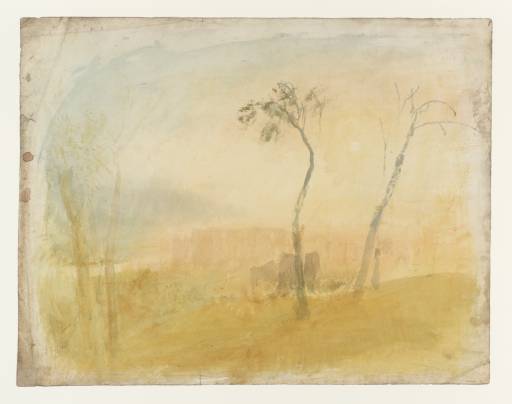Joseph Mallord William Turner St Agatha's Abbey, Easby c.1825-30
Joseph Mallord William Turner,
St Agatha's Abbey, Easby
c.1825-30
Joseph Mallord William Turner 1775–1851
St Agatha’s Abbey, Easby c.1825–30
D25153
Turner Bequest CCLXIII 31
Turner Bequest CCLXIII 31
Watercolour on white wove paper, 390 x 501 mm laid down on white wove paper trimmed to the same dimensions
Inscribed in red ink ‘31’ bottom right
Blind-stamped with Turner Bequest monogram towards bottom right
Stamped in black ‘CCLXIII – 31’ bottom right
Inscribed in red ink ‘31’ bottom right
Blind-stamped with Turner Bequest monogram towards bottom right
Stamped in black ‘CCLXIII – 31’ bottom right
Accepted by the nation as part of the Turner Bequest 1856
Exhibition history
1965
[Display of watercolours from the Turner Bequest], Tate Gallery, London, ?–?March 1965 (no catalogue, as ‘A sunny landscape’).
1984
Turner’s Tour of Richmondshire/Yorkshire: In Turner’s Footsteps through the Hills and Dales of Northern England, Tate Gallery, London, July–December 1984 (no catalogue, as a Bolton Abbey subject).
2002
Turner et le Lorrain, Musée des beaux-arts, Nancy, December 2002–March 2003 (76, reproduced in colour, as ‘St Agatha’s Abbey, Easby’, c.1825–30).
2013
Turner: Works on Paper, Tate Britain, London, April 2013–ongoing (no catalogue).
References
1909
A.J. Finberg, A Complete Inventory of the Drawings of the Turner Bequest, London 1909, vol.II, p.816, CCLXIII 31, as ‘A sunny landscape’. c.1820–30.
1984
David Hill, In Turner’s Footsteps: Through the Hills and Dales of Northern England, London 1984, p.31, as relating to St Agatha’s Abbey.
1997
Eric Shanes, Turner’s Watercolour Explorations 1810–1842, exhibition catalogue, Tate Gallery, London 1997, p.95 Appendix I under ‘England and Wales Series’, as ‘Sketch for a view of Bolton Abbey from the north’. ?c.1828, p.103 under ‘Yorkshire’, as ‘?Sketch for a view of Bolton Abbey from the north. c.1828, made for the England and Wales series’, p.104 Appendix II, as ‘Sketch: Bolton Abbey?’.
2002
Ian Warrell in Warrell, Blandine Chavanne and Michael Kitson, Turner et le Lorrain, exhibition catalogue, Musée des beaux-arts, Nancy 2002, pp.149 no.76, reproduced in colour, 197, as ‘St Agatha’s Abbey, Easby’. c.1825–30.
In positing this colour study as an undeveloped subject for Turner’s Picturesque Views in England and Wales, Eric Shanes notes that Bolton Abbey, North Yorkshire, was suggested as the subject in its display caption for the 1984 Tate Gallery exhibition Turner’s Tour of Richmondshire/Yorkshire, organised by Judy Egerton and David Hill.1 However, in Hill’s related book, it was noted as relating to a pencil drawing of ‘St. Agatha’s Abbey, Easby from the south-east, Richmond in the distance’ in the 1816 Yorkshire 4 sketchbook (Tate D11474; Turner Bequest CXLVII 21).2
The side elevation of a ruined Gothic church seen through trees superficially resembles an 1816 view of Bolton Abbey from the north in the Devonshire Rivers, No.3, and Wharfedale sketchbook (Tate D09876; Turner Bequest CXXXIV 75); a view from the south in the same sketchbook (Tate D09885, D09887; Turner Bequest CXXXIV 81, 82) was the basis of the watercolour Bolton Abbey, Yorkshire of about 1825 (Lady Lever Art Gallery, Port Sunlight),3 engraved in 1827 for England and Wales.
In fact, the Yorkshire 4 Easby sketch appears indisputably to be the source here: despite the lack of detail in the distance, various incidental architectural details, including smaller buildings silhouetted in front of the ruin and an arch corresponding to one in the pencil drawing towards the right, correlate closely, while the forms of all the trees in the foreground, rough as they appear, are also traceable directly to those in the sketch. Only the sun, a reserved disk of white paper in the golden sky, between the two trees towards the right, is misleading, in that in placing it there Turner shows it shining from the north. It was clearly placed there as part of an ‘ethereal’,4 contre-jour effect recalling Claude Lorrain (1604/5–1682), so admired and so often emulated by Turner.5
Turner had first visited the site in 1797, recording the ruin in the North of England sketchbook (Tate D00930, D00931; Turner Bequest XXXIV 24, 25) and subsequently making watercolours of other aspects (Whitworth Art Gallery, Manchester; British Museum, London).6 A watercolour of about 1821 (also British Museum),7 compositionally related to the Whitworth’s but probably also informed by a pencil view in the 1816 Yorkshire 2 sketchbook (Tate D11224; Turner Bequest CXLV 112), was engraved in 1822 for Whitaker’s History of Richmondshire (Tate impressions: T04443, T04444, T06036).
The dating of the present work to about 1825–30 follows the most recent published suggestion,8 which is in line with the early years of the England and Wales project. For another England and Wales-type colour study, possibly showing Easby, see Tate D25211 (Turner Bequest CCLXIII 89). See also the introductions to the present subsection of identified but unrealised subjects and the overall England and Wales ‘colour beginnings’ grouping to which this work has been assigned.
Verso:
Blank, save for inscriptions: stamped in black with Turner Bequest monogram above ‘CCCLXIII – 31’; inscribed in pencil ‘AB 260 P’ and ‘CCLXIII 31’ bottom right.
Blank, save for inscriptions: stamped in black with Turner Bequest monogram above ‘CCCLXIII – 31’; inscribed in pencil ‘AB 260 P’ and ‘CCLXIII 31’ bottom right.
The ‘AB’ number corresponds with the endorsement on one of the parcels of works sorted by John Ruskin during his survey of the Turner Bequest, in this case classified by him as ‘Colour on white. Larger and later’.1
Matthew Imms
March 2013
How to cite
Matthew Imms, ‘St Agatha’s Abbey, Easby c.1825–30 by Joseph Mallord William Turner’, catalogue entry, March 2013, in David Blayney Brown (ed.), J.M.W. Turner: Sketchbooks, Drawings and Watercolours, Tate Research Publication, December 2013, https://www

